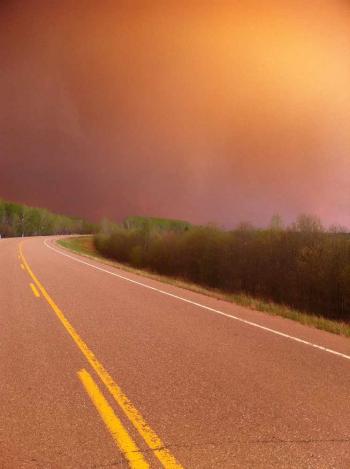Image Caption
Summary
Andrea Smith
Windspeaker.com Contributor
While wildfires are disruptive to everyone, they are particularly disruptive for people in First Nations communities.
One-third of all wildfire evacuations in Canada over the last 30 years have impacted Indigenous people, despite their being only 4.3 per cent of the population, according to a team of researchers who are studying the effects of wildfires on those who are evacuated because of them.
Dr. Amy Christianson is one of five researchers iwho are working together with First Nations communities and Indigenous branches of government under the First Nations Wildfire Evacuation Partnership.
“The partnerships came about because these agencies wanted to see what was happening on the ground in First Nations communities during evacuations… The overall purpose was to improve evacuation experiences, to see what we could do to improve evacuation centres, and what we can do to give people more time to evacuate,” said Christianson.
The other researchers on Christianson’s team are University of Alberta’s Tara McGee, Henok Asfaw, and Kyla Mottershead, and University of Tasmania’s Douglas Patonon. Christianson works for the Canadian Forest Service.
The communities partnered with the research team are the Driftpile First Nation, the Dene Tha Nation, the Whitefish Lake First Nation, the Onion Lake Cree Nation, the Lac La Ronge Indian Band, the Deer Lake First Nation, the Sandy Lake First Nation, and the Mishkeegogamang Ojibway First Nation.
These nations are found in Alberta, Ontario, and Saskatchewan. And government organizations helping the cause include Aboriginal Affairs and Emergency Management, Health Canada, and the First Nations Emergency Services Society of B.C.
The researcher’s method was to go into the communities and talk with people directly, about their experience of being evacuated, after they had been let back in and settled. They found evacuations can actually cause a significant amount of grief for the people who were evacuated.
“We found evacuations do have huge mental health impacts on First Nations people. Even when we’ve interviewed people four to five years after the event, they were still crying about what happened,” said Christianson, adding that an associate of hers recently offered her insight into why this might be the case.
“She was thinking it’s triggering for people who went to residential school because you’re taking people from their homes… And they’re sleeping in big communal rooms. They have to line up for food, and they can be separated from family and friends,” she said.
According to Christianson, the evacuation strategy used most frequently can also cause the most trauma. Evacuating vulnerable people first can mean Elders—along with children, pregnant women and people with chronic health issues— are sent away, without family or friends for support.
Christianson gives one example of a situation in Ontario, where Elders who didn’t even speak English left their rural communities and were sent into downtown Ottawa, an incredibly isolating experience. And this is exactly the kind of situation the researchers are trying to prevent, she said.
“The people managing this are human, too, and they’re just trying to help people. But they might not be thinking about these things,” said Christianson.
This is particularly interesting, given that Chief Joe Alphonse of the Tl’etinquox First Nation in B.C. is currently refusing to evacuate his community, despite recommendations coming from government officials, a situation which recently led to conflict with local RCMP.
Christianson and her colleagues found evidence in their studies to support Alphonse’s sentiment. A huge portion of people she interviewed said that after experiencing an evacuation, they wouldn’t leave again if another evacuation was called. And while it can be dangerous, there is also some benefit, said Christianson.
“It’s hard because you are always taking a risk when staying behind. You don’t know the potential fire behavior, and that’s why they evacuate… to save lives,” she said. “But people in the community are able to provide real time info about what’s happening. The people can say ‘Oh Julie, I drove by your house, and it’s fine,’” she said, adding that one thing they found in evacuation centers, was that “rumours spread.”
The Stand and Defend tactic—as it’s known in Australia—is when people stay behind to use actually fight the fire. Alphonse is reported in the media as saying this is exactly what he and his community are planning to do.
According to Christianson, this has been successful in the past, with some of the communities her team interviewed. Local firefighters in Whitefish Lake First Nation, for example, credit themselves with saving their community from encroaching fire in 2011.
But the real issue is safety, and the quality of the equipment that is being used during “Stand and Defend.” For this approach to be fully successful—as well as safe for the people doing it—the communities would need funding for better equipment, including personal protective gear, as well as firefighting equipment, and also to be connected to government communication systems so everyone can work together effectively, said Christianson.
Looking at what people need, the cost of what they need, and how to ensure they get it, is also part of Christianson’s and the wildfire partnership’s mandate.
“Lots of people want to stand and fight and protect their community... They’re so passionate, they’re willing to stand behind and risk their lives… and that’ something we need to understand,” she said.
More information can be found on the project website: http://www.eas.ualberta.ca/awe/

